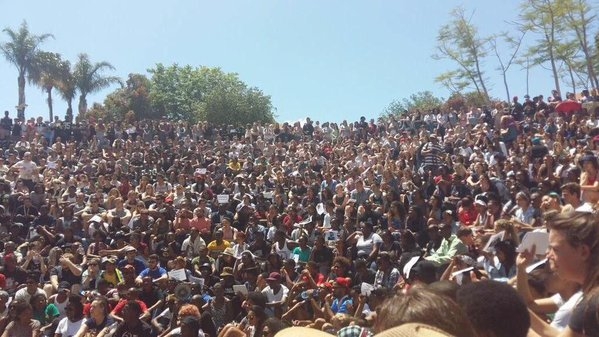On Wednesday, 21 October, students shut down all major universities across the country in extraordinary scenes last witnessed in the 1980’s.
Wednesday’s events marked a qualitative change in the entire situation.It represents the early winds which precede a coming hurricane which is on course to make a direct hit. The immediate catalyst for the protests is the recently announced increase in university fees, and more generally the exorbitant cost of higher education, which exclude the poor and mostly black students from the higher education system.
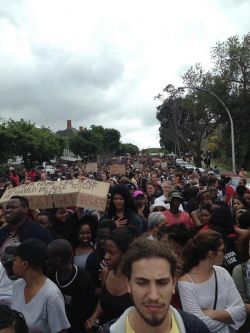 The scenes which played themselves out on Wednesday were unprecedented for an entire generation of students. All the major universities closed, including the University of Pretoria, the University of the Free State, the University of Cape Town, the Nelson Mandela Metropolitan University, Eastcape Midlands College, the University of Fort Hare, the University of Witwatersrand, Rhodes University, University of Limpopo, Central University of Technology, Cape Peninsula University of Technology, University of Western Cape, Walter Sisulu University, Stellenbosch University Tshwane University of Technology, and North West University.
The scenes which played themselves out on Wednesday were unprecedented for an entire generation of students. All the major universities closed, including the University of Pretoria, the University of the Free State, the University of Cape Town, the Nelson Mandela Metropolitan University, Eastcape Midlands College, the University of Fort Hare, the University of Witwatersrand, Rhodes University, University of Limpopo, Central University of Technology, Cape Peninsula University of Technology, University of Western Cape, Walter Sisulu University, Stellenbosch University Tshwane University of Technology, and North West University.
At Stellenbosch, students occupied the major buildings and a central square in the university town. In Johannesburg, Wits University students marched in the rain to the commercially important Braamfontein area. At the university of UKZN, Nelson Mandela Metropolitan University, and Limpopo University, police attacked the protesters with rubber bullets and tear gas.
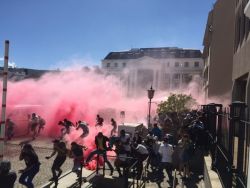 But the most dramatic events played themselves out in Cape Town. Thousands of students from the universities of Cape Town, Cape Peninsula University of Technology, and Western Cape marched on parliament, where the finance minister gave his medium term budget statement. Their intention, they said, was to talk to Nzimande, the Higher Education Minister. Using one of the main entrances, students, singing the national anthem, forced their way into the parliamentary precinct and reached the steps of the National Assembly before the police attacked them with tear gas and stun grenades.
But the most dramatic events played themselves out in Cape Town. Thousands of students from the universities of Cape Town, Cape Peninsula University of Technology, and Western Cape marched on parliament, where the finance minister gave his medium term budget statement. Their intention, they said, was to talk to Nzimande, the Higher Education Minister. Using one of the main entrances, students, singing the national anthem, forced their way into the parliamentary precinct and reached the steps of the National Assembly before the police attacked them with tear gas and stun grenades.
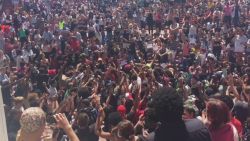 This was a completely unprovoked attack. The students were peaceful, folding their arms above their heads to show that they were not armed. But this was to no avail. Students were attacked and beaten, and some were arrested. This did not deter the students. In amazing and haunting scenes of defiance, they regrouped and sang the entire national anthem while being charged by police and fired upon with stun grenades. In a moment of symbolic importance, one of the grenades fired by the police flew straight over the bronze bust of Nelson Mandela at the front of the National Assembly. Later, students were driven around in police vans and threatened with charges of high treason for entering a “National Keypoint.”
This was a completely unprovoked attack. The students were peaceful, folding their arms above their heads to show that they were not armed. But this was to no avail. Students were attacked and beaten, and some were arrested. This did not deter the students. In amazing and haunting scenes of defiance, they regrouped and sang the entire national anthem while being charged by police and fired upon with stun grenades. In a moment of symbolic importance, one of the grenades fired by the police flew straight over the bronze bust of Nelson Mandela at the front of the National Assembly. Later, students were driven around in police vans and threatened with charges of high treason for entering a “National Keypoint.”
 Inside parliament, MPs from the Economic Freedom Fighters were violently evicted after demanding that the minister’s speech be postponed and that it can’t be ‘’business as usual’’ when students are at parliament’s doors. After they were removed, the situation turned to the opposite. While police beat protesters outside, inside the House the minister read out his speech in slow monotone. President Zuma sat expressionless, occasionally adjusting his glasses. All around him ministers, parliamentarians, “dignitaries,” and “esteemed guests” sat ashen-faced in the pristine surroundings of the Assembly, listening to the minister talking about his medium-term budget policy statement. When he finished, there was polite applause and even more polite conversation. This reveals how far removed these people are from the daily struggles of the South African workers and students.
Inside parliament, MPs from the Economic Freedom Fighters were violently evicted after demanding that the minister’s speech be postponed and that it can’t be ‘’business as usual’’ when students are at parliament’s doors. After they were removed, the situation turned to the opposite. While police beat protesters outside, inside the House the minister read out his speech in slow monotone. President Zuma sat expressionless, occasionally adjusting his glasses. All around him ministers, parliamentarians, “dignitaries,” and “esteemed guests” sat ashen-faced in the pristine surroundings of the Assembly, listening to the minister talking about his medium-term budget policy statement. When he finished, there was polite applause and even more polite conversation. This reveals how far removed these people are from the daily struggles of the South African workers and students.
But the students did not give up. “We want Blade. We want Blade,” they chanted, referring to Blade Nzimande, the Minister of Higher Education.
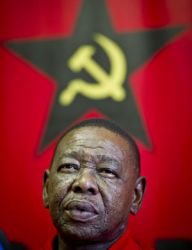 Blade NzimandeNzimande, flanked by some of the ministers in the security cluster, tried to address the students outside Parliament, but his loudspeaker failed to work properly. Students chanted ‘’Blade out . . . Zero. Zero. Zero,” “down with Blade,” and “Blade Must Fall.” He was booed as he walked away, followed by more singing. A water bottle was hurled at the minister as he entered parliament. Never before has a politician been so thoroughly exposed in post-apartheid South Africa. Nzimande is not just a minister, he is the General Secretary of the South African Communist Party. The symbolism of that moment cannot be overstated.
Blade NzimandeNzimande, flanked by some of the ministers in the security cluster, tried to address the students outside Parliament, but his loudspeaker failed to work properly. Students chanted ‘’Blade out . . . Zero. Zero. Zero,” “down with Blade,” and “Blade Must Fall.” He was booed as he walked away, followed by more singing. A water bottle was hurled at the minister as he entered parliament. Never before has a politician been so thoroughly exposed in post-apartheid South Africa. Nzimande is not just a minister, he is the General Secretary of the South African Communist Party. The symbolism of that moment cannot be overstated.
The current events started a week ago when protests erupted at Wits University against a 10.5 percent increase in fees for next year. Over three days the movement engulfed the entire university, culminating in a mass occupation of the Senate House Braamfontein campus. On Friday the vice-chancellor, Adam Habib, went to address the students at the occupied buildings. This turned out to be a long day for Habib. The students refused to be addressed by him unless he promised that there would be zero fee increments for 2016. Then, surrounded by thousands of students, he found that he could not leave. He spent more than 12 hours sitting on the ground, surrounded by students singing revolutionary songs. One attack by university security against the occupied building was repelled by the students, and Habib was left seated until early Saturday morning.
At 5 a.m. Saturday, the university decided to play for time. The university council suspended the decision to increase fees for next year until the deal is negotiated anew. This was a clear delaying tactic. The next day, the council met again, and two days later they did not even turn up to report back to the students as promised.
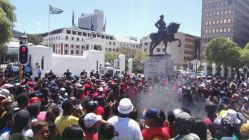 By now the protests have spilled over to other universities. The hashtag “Fees Must Fall” was used on social media to mobilise the protests against increasing tuition fees. On Tuesday, 20 October, the South African Students Congress (SASCO) called for a total shutdown for the next day. Then a National Shutdown Collective issued a statement which explained the action:
By now the protests have spilled over to other universities. The hashtag “Fees Must Fall” was used on social media to mobilise the protests against increasing tuition fees. On Tuesday, 20 October, the South African Students Congress (SASCO) called for a total shutdown for the next day. Then a National Shutdown Collective issued a statement which explained the action:
We, the students of 2015, stand in solidarity with one another to proclaim that we will not be complicit in the endorsement of the capitalist agenda of commodification of education and any oppressions which seek to denigrate our being. We demand, among other things, that the exorbitant fees charged at institutions of higher learning be lowered in line with a progression toward opening the gates of higher learning for all.
By now a crisis broke out in government. The Minister of Higher Education, Blade Nzimande, harried around, meeting university administrators and other “stakeholders” to find a solution to the growing revolt. After his meeting with the president and the bureaucrats, Nzimande believed he had found a solution. He announced that the “stakeholders” had agreed to cap any increase to 6 percent. He informed the country of president Zuma’s “relief” that there was a “light at the end of the tunnel.” “The president expressed relief that at least there seems to be possibly some light at the end of the tunnel, because the parties have come up with a framework which provides a compromise. The president, by the way, is a very skilled and highly experienced negotiator so he understands that this is important. I can’t speak for the president but he understands that it is important that the parties find each other so that we can stabilise the situation in our universities,” Nzimande said.
But they completely misread the situation. That “light” turned out to be an oncoming train. The students rejected this new deal and forged ahead with Wednesday’s action.
The student protests over higher fees and for free education represent a turning point in the entire situation. This is not merely about fees. It is about a new generation who do not see any future for themselves in this exploitative system. South Africa has a history of student revolts, and these have always been followed by the movement of workers. In June 1976, the SOWETO uprisings and the mass youth uprisings were the prelude to the mass revolutionary movements of the 1980’s which were led by the working class.
Just a week ago, the metal workers sent a warning to the entire establishment. Barely a few days later, the revolutionary students announced their intent that there is no more business as usual. Lenin wrote that there are decades where nothing happens; and there are weeks where decades happen. This is the situation today in South Africa. Already there is talk of a mass march to the Union Buildings, the seat of government on Friday.
Marxists have always said that in the last analysis, the state is armed bodies of men defending private property. The masses may vote for whoever they want, but in the final analysis, it is the capitalists who decide. This lesson is now being learned by a new generation of students.
At bottom, these events are not only against fees. They are directed at the capitalist system and those who uphold it. All the contradictions are piling up and are threatening to explode, like a ticking time bomb. And then there is the ANC government. Time and again it has made promises which it cannot deliver. This is no surprise. The problem is that the ANC is clinging to the capitalist system. But if you accept the system, then you must accept its logic and its consequences.
One of the promises which it cannot keep is the promise of free education. Ironically, this year is the 60th anniversary of the Freedom Charter. The ruling party swears high and low by it. The ANC has even dedicated the entire year to that historic document, which was drawn up by participants from the length and breadth of the country six decades ago. On the issue of the charter says the following:
Education shall be free, compulsory, universal and equal for all children; Higher education and technical training shall be opened to all by means of state allowances and scholarships awarded on the basis of merit.
But more than this, it also gives the material premise on which this should be built:
The mineral wealth beneath the soil, the Banks and monopoly industry shall be transferred to the ownership of the people as a whole.
These words have never been more relevant. In the last analysis, this is the only solution to the crisis of capitalism and the crisis of education. Only by nationalising the land, the banks, industry, and the commanding heights of the economy, under democratic workers’ control and management, will the material conditions exist for full employment, the abolition of poverty and inequality, and the attainment of free, quality education for all, as the Freedom Charter demands.

